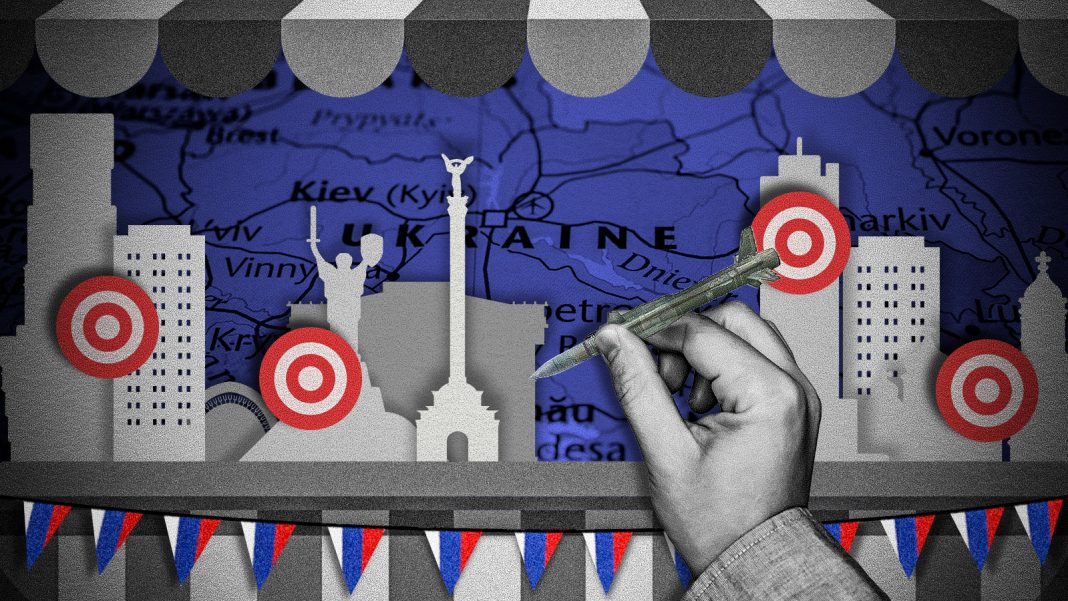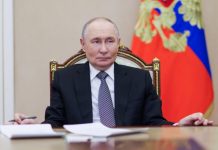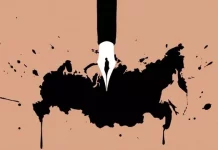The month of May is usually associated with joy, springtime, and the approaching summer. In the Russian info-sphere, this May is the second year of the full-scale war on Ukraine. A year ago, it dawned on Moscow that conquering Ukraine would not be the easy task initially presumed. The Battle of Kyiv had been lost in April and international sanctions and support for Ukraine had begun to flow more systematically with the first US-led Ramstein meeting on 26 April.
Increasingly, Russian forces would prefer stand-off fighting: artillery, missile, or aircraft bombardments even if state and pro-Kremlin media praised the bravery of infantry facing danger and advancing victoriously. If the endless daily announcements by the Russian Ministry of Defence heralding Russian successes and the losses of the ‘Ukro-Nazi’ enemy had been true, the Russian Army would soon have arrived at Ukraine’s western border with Poland. During the following months, perhaps to compensate for the lack of real territorial advances, the ‘joy of bombing’ became a feature in Russian mainstream discussion where calls for the genocidal annihilation of everything Ukrainian had already flourished in key state outlets since the spring.
Despite Russian attempts at its annihilation, Ukraine recently celebrated its resilience and solidarity of society through the winter of Russian terror.
Happy patriotic 1 May!
Everything in Russia is affected by the war despite attempts by state-controlled media to put a happy spin on 1 May and gloss over the reality. Now, it’s about ‘patriotism’, shorthand for militarisation of the public space and worship of the strong leader. 1 May gatherings and public events across Russia not only featured balloons and flowers but also a heavy dose of the banners associated with 9 May Victory Day celebrations: the Red Army victory flag and St. George black-and-yellow ribbons. Mobilise for 1 May!
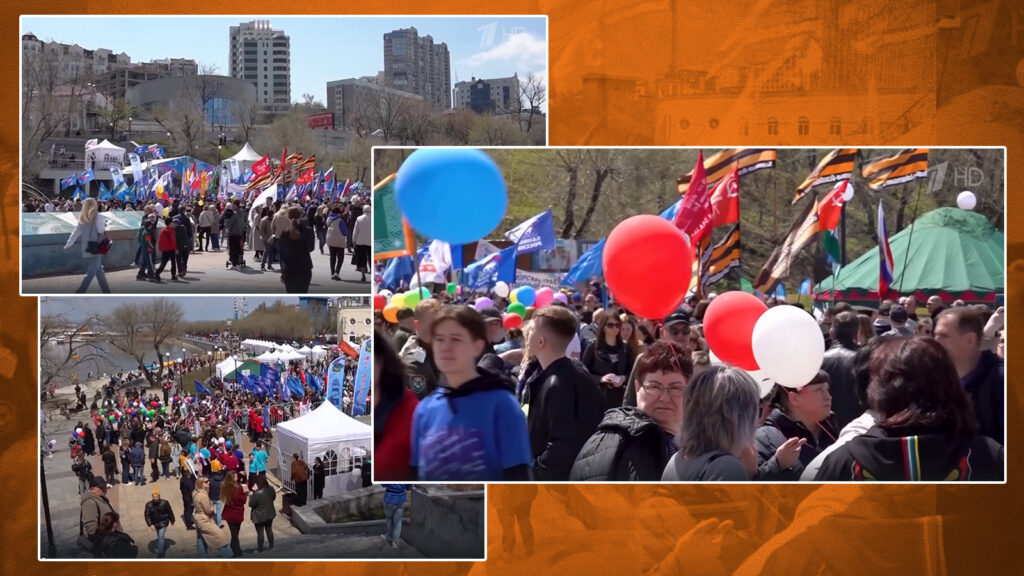
Thank you. Congrats on the shelling!
True to their habit of bombing on special occasions, Russian forces launched a major missile attack across Ukraine on 1 May, as well as on 27 and 28 April, to again spread terror and fear. The regions around Mykolajiv, Uman, Dnipro, and Kyiv were especially targeted, especially civilian targets. It had been some time since the last country-wide attack on 9 March, seen as a commemoration of sorts for 8 March, International Women’s Day (widely celebrated in Ukraine as well as in Russia). See also our recent account of the narratives around missile bombardments.
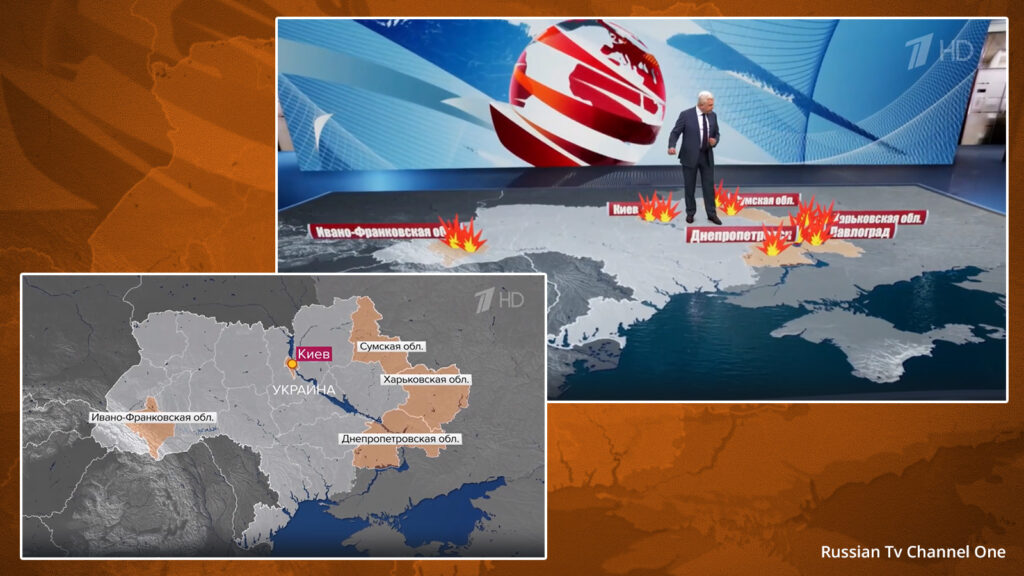
Please also note the manipulative and provocative TV map of Ukraine that pretends that the Russian Federation has expanded along the Black Sea coast and beyond the Dnipro river.
The Russian Ministry of Defence heralded, as always, the latest missile attacks as ‘right on target’. State outlets also triumphantly announced that the bombings ‘only [hit] strictly military targets’. However, mobile phone cameras instantly conveyed images from the real impacted areas. It is getting increasingly difficult to convince world audiences that high-rise residential apartment buildings, children’s playgrounds, and ordinary houses with pensioners represent ‘important military targets’. According to local information from the Pavlohrad district, 19 residential high-rise buildings, 25 houses, and one industrial building were hit. On 28 April in Uman, 23 civilians were killed when a missile hit a residential high-rise building. The death toll from the attacks is still rising.
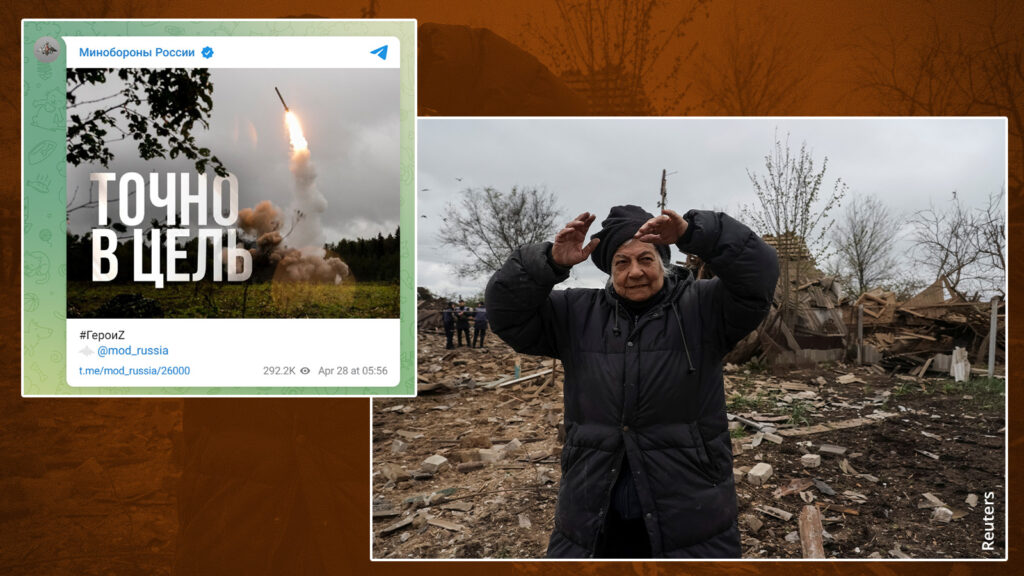
Only a twisted mind, disregarding the basic laws of war, would consider all Ukrainian civilians and their homes to be part of Ukraine’s defence and ‘legitimate’ targets. As Russian leaders boast of ‘modern precision-guided weapons’, in truth all of Ukraine became an indiscriminate target of Moscow.
Is shelling popular?
The horrific fact is that this targeting of civilians is not by accident, but by design. And by now, Russian soldiers and decision-makers and supporters down through the chain of command have all the information they need to avoid hitting civilians and civilian infrastructure. Despite censorship and restrictions, Telegram, YouTube, RuTube, VKontakte, and TikTok etc. all communicate information. After more than 14 months of full warfare, with an abundance of imagery and reports, it is not an absence of information which leads Russian military leaders and individual soldiers to target civilians.
In a recent study by the international Gallup pollster, Russia’s international approval ratings have substantially deteriorated. Not everybody believes the lies about ‘legitimate military targets’. Later, we will look deeper into how international disinformation campaigns shape perceptions in other countries. Back in Russia, the Kremlin tune seems still to have significant traction, at least according to recent studies by the independent and respected Russian sociological Levada Centre. According to the Centre, more than 70% of respondents partially or fully support the war, a figure that has held steady since February 2022.
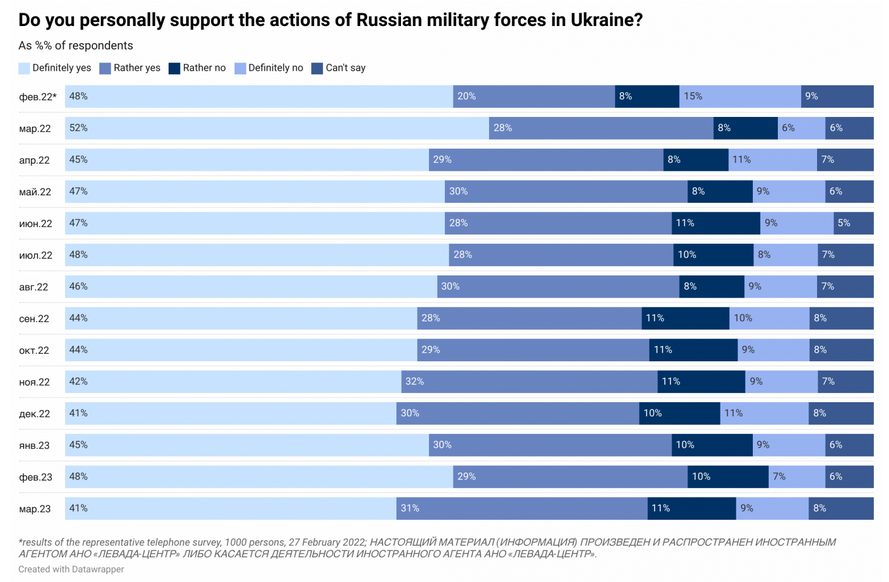
The West is arming Ukraine so we have to bring peace
It may sound repetitive but the Kremlin keeps claiming that ‘Kyiv started the war so Russia has to bring peace’. As always, the West is said to be the sinister hand behind Kyiv’s actions. Pictures from Ukraine show what is meant by ‘peace’ or ‘de-Nazification’: widespread destruction and murder.
Warming up to 9 May: what to expect
The volume of Kremlin rhetoric in state TV outlets is being turned up, like in this example: the West is waging a war against Russia and Ukraine is only used as a hammer.
Last year we provided you with a preview of 9 May events and it turned out to match the Kremlin’s playbook. This year, be prepared for a toxic cocktail of Putin’s twisted, upside-down history lessons and verbal attacks against the West accompanied by near-apocalyptic nuclear sabre-rattling.
Even if six Russian regions near Ukraine have cancelled parades, we expect roads around Moscow’s Red Square will sport over-sized vehicles intended for ballistic and other missiles. The sky over Moscow will likely see military jets. Speakers blaring augmented pathos will claim the invincibility and immortality of historic Russia and draw a straight historical line from Stalingrad to Sevastopol and today’s trenches. Outlets may compare the urban warfare and colossal artillery destruction in Bakhmut to that of Berlin in World War II. A giant ‘Z’ already covers buildings in Moscow.
High-level, international guests will be low in number. This is more a concern for the Kremlin than they are ready to admit publicly since it illustrates the degree of Russia’s isolation. But to the public, the message may be spun: ‘This is our, Russian celebration and who cares about foreigners.’
Not all will be glory. The atrocious war in Ukraine has not offered victory and high casualty rates are a big problem. The only way forward is to use the old trick: it’s for the defence of the Motherland! The war is existential, about the survival of Russia! People unable or unwilling to agree will be rooted out or given lengthy prison sentences, as happened to Vladimir Kara-Murza. He recently got 25 years in prison precisely for criticising the war, exceeding similar Soviet-era prison sentences.
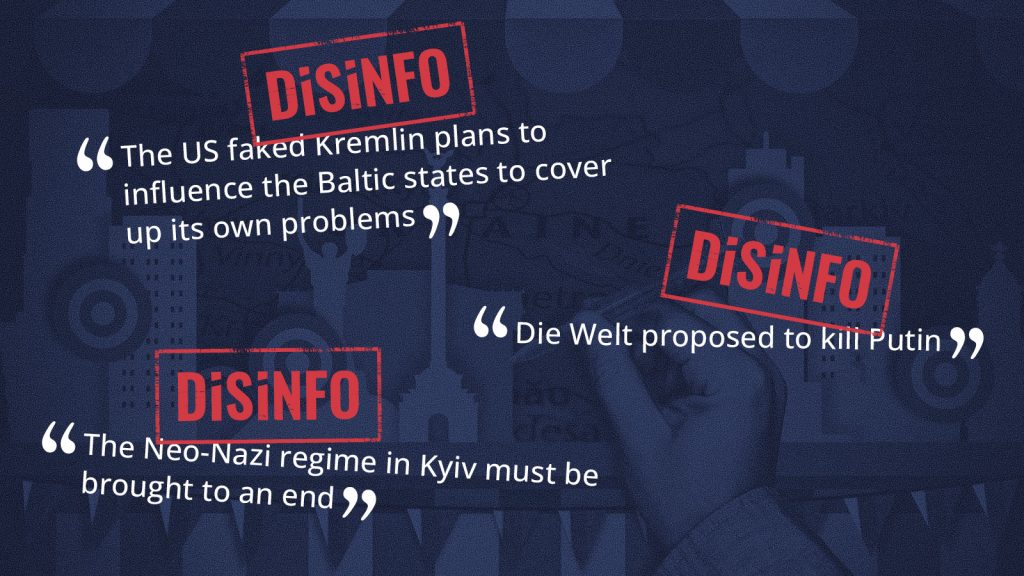
Also on EUvsDisinfo’s radar this week:
- The US faked alleged Kremlin plans to influence the Baltic states to cover up its own problems. This story is a classic Kremlin technique to try shift the blame to others when independent investigative journalists from multiple, reputable media dig out and expose new tricks in the Russian hybrid toolbox. As several EU countries have weakened Russian spy networks by expelling agent-diplomats, Moscow has tried to find alternative ways to exert influence.
- Die Welt proposed killing Putin. This piece of disinformation and manipulation is illustrative for several reasons. First, it was broadcast on a leading Russian state TV station, Rossiya 1, so it reflects ‘his Master’s Voice’. Second, it grossly misrepresented the content of a reputable media outlet, in this case the German newspaper Die Welt, so it aims to discredit independent media, the very foundation of free exchange of information and opinion in our democracies. The article in Die Welt never mentions killing Putin. Third, it seeks to shift the focus of the discussion by assigning sinister motives to an opponent. Fourth, it reflects a taboo in Russia: discussing the fate of the great leader is a capital sin. He embodies modern Russia, as once said by Vyacheslav Volodin, now the Duma (parliament) speaker: ‘There is no Russia today if there is no Putin’.
- The neo-Nazi regime in Kyiv must be brought to an end. Heard it before? Yes, about a million times. But the important aspect here is that it reflects current thinking in the pro-Kremlin disinformation ecosystem and thus inside Moscow. Not a year ago, but today, as you read this article. The thinking is immune to more than 14 month of hard warfare, over 100,000 deaths, and additional Russian losses. Immune to calls to reach an accord with Kyiv, an understanding, or a peace deal. The manipulative insistence that the enemy in Kyiv is simply Nazi, despite tons on debunking evidence (see more our than 1,000 cases), illustrates there is no turning back.
Prepare for 9 May.


